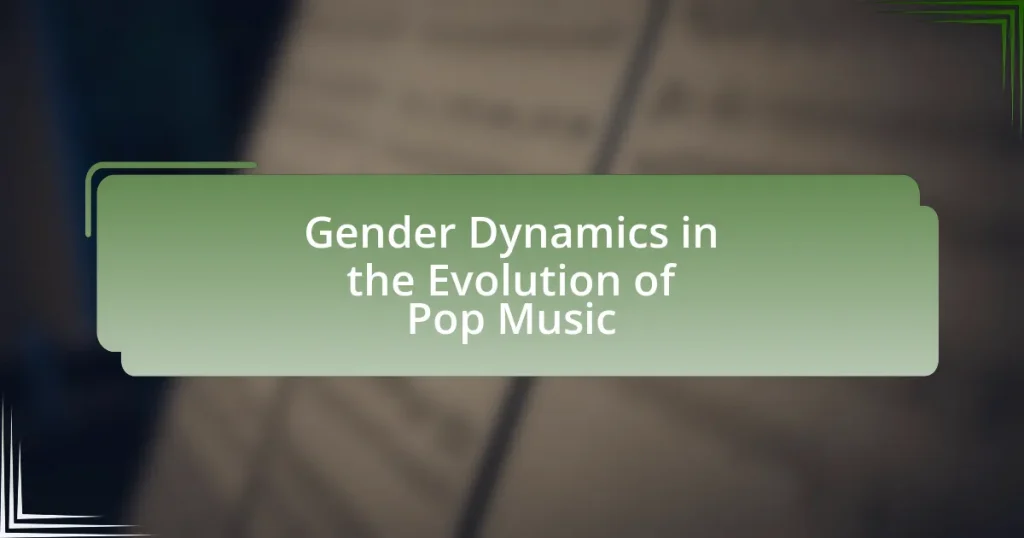The article examines the gender dynamics in the evolution of pop music, highlighting the historical shifts in representation and influence of male and female artists. It discusses how female artists have increasingly challenged traditional gender roles, particularly from the 1960s onward, with notable figures like Aretha Franklin, Madonna, and Beyoncé leading the way. The piece also addresses the impact of societal perceptions on music trends, the role of various genres in shaping gender dynamics, and the ongoing challenges faced by artists in achieving equality. Key milestones and current trends in gender representation are explored, alongside the implications for the music industry and future directions for gender diversity in pop music.

What are the Gender Dynamics in the Evolution of Pop Music?
Gender dynamics in the evolution of pop music reflect significant shifts in representation, influence, and societal perceptions of gender roles. Historically, male artists dominated the pop music landscape, with women often relegated to supporting roles or stereotypical representations. However, from the 1960s onward, female artists began to gain prominence, exemplified by figures like Aretha Franklin and Madonna, who challenged traditional gender norms and asserted their agency in the industry.
The 1990s and 2000s saw an increase in female empowerment themes, with artists like Britney Spears and Beyoncé shaping the narrative around women’s sexuality and independence. Research indicates that female artists have increasingly taken on roles as producers and songwriters, contributing to a more equitable industry. For instance, a study by the USC Annenberg Inclusion Initiative found that women comprised only 21.6% of artists in popular music from 2012 to 2019, highlighting ongoing disparities but also indicating a gradual increase in female representation.
Overall, the gender dynamics in pop music have evolved from male dominance to a more diverse and inclusive landscape, reflecting broader societal changes regarding gender equality and representation.
How have gender roles influenced the development of pop music?
Gender roles have significantly influenced the development of pop music by shaping the themes, representation, and marketing strategies within the genre. Historically, male artists dominated the pop music landscape, often dictating the narrative and style, while female artists were frequently relegated to roles that emphasized their appearance and romantic relationships. For instance, the 1980s saw male rock bands like Bon Jovi and Guns N’ Roses achieving mainstream success, while female pop stars like Madonna and Whitney Houston began to challenge these norms by asserting their artistic control and sexual agency. This shift not only expanded the thematic range of pop music but also led to the emergence of diverse sub-genres, such as girl power anthems in the 1990s, exemplified by the Spice Girls, which promoted female empowerment and solidarity. Furthermore, the rise of social media has allowed artists of all genders to bypass traditional gatekeepers, leading to a more inclusive and varied pop music scene that reflects a broader spectrum of gender identities and experiences.
What historical events shaped gender dynamics in pop music?
The historical events that shaped gender dynamics in pop music include the feminist movements of the 1960s and 1970s, which challenged traditional gender roles and promoted female empowerment in the music industry. The emergence of female artists like Aretha Franklin and Janis Joplin during this period highlighted women’s voices and experiences, leading to greater representation in pop music. Additionally, the introduction of MTV in the 1980s transformed the visual aspect of music, allowing female artists such as Madonna and Whitney Houston to redefine femininity and sexuality in their performances, further influencing gender dynamics. The #MeToo movement in the late 2010s also played a crucial role in addressing issues of sexual harassment and inequality within the industry, prompting a reevaluation of women’s roles in pop music. These events collectively contributed to the ongoing evolution of gender dynamics in the genre.
How have societal perceptions of gender impacted pop music trends?
Societal perceptions of gender have significantly influenced pop music trends by shaping the themes, imagery, and roles of artists within the genre. For instance, the rise of feminist movements in the 1970s led to the emergence of female artists like Madonna and Janet Jackson, who challenged traditional gender norms and embraced sexual empowerment, thus altering the portrayal of women in music. Additionally, the increasing visibility of LGBTQ+ identities has prompted artists such as Sam Smith and Lil Nas X to explore themes of gender fluidity and sexuality, reflecting broader societal acceptance and reshaping audience expectations. This evolution is evidenced by the Billboard charts, where songs addressing gender identity and empowerment have gained mainstream success, indicating a shift in listener preferences towards more inclusive narratives.
What are the key milestones in the evolution of gender representation in pop music?
Key milestones in the evolution of gender representation in pop music include the emergence of female artists in the 1960s, such as Aretha Franklin and Janis Joplin, who challenged traditional gender roles. The 1980s saw the rise of pop icons like Madonna, who used her platform to explore themes of female empowerment and sexuality, significantly influencing gender norms in music. In the 1990s, artists like Britney Spears and Spice Girls popularized a new wave of female representation, blending femininity with commercial success. The 2000s introduced a more diverse range of voices, including artists like Beyoncé and Lady Gaga, who addressed issues of race, sexuality, and feminism. Recent years have seen a further shift with the emergence of non-binary and gender-fluid artists, such as Sam Smith and Lil Nas X, expanding the conversation around gender in pop music. These milestones reflect a continuous evolution in how gender is represented and perceived within the genre.
Which artists have been pivotal in challenging gender norms in pop music?
Artists such as Madonna, Lady Gaga, and Prince have been pivotal in challenging gender norms in pop music. Madonna’s provocative imagery and themes of female empowerment in the 1980s redefined the role of women in the industry, while Lady Gaga’s androgynous style and advocacy for LGBTQ+ rights have further blurred traditional gender lines. Prince’s exploration of sexuality and gender fluidity in his music and performances also played a significant role in reshaping perceptions of masculinity and femininity in pop culture. These artists have not only influenced their contemporaries but have also left a lasting impact on the evolution of gender dynamics in the music industry.
How have different music genres influenced gender dynamics in pop music?
Different music genres have significantly influenced gender dynamics in pop music by shaping the representation and roles of male and female artists. For instance, the rise of rock music in the 1960s and 1970s often emphasized male dominance, with male rock stars frequently portraying aggressive and rebellious personas, which marginalized female artists. In contrast, the emergence of pop and R&B genres in the 1980s and 1990s allowed female artists like Madonna and Whitney Houston to assert their sexuality and independence, thereby challenging traditional gender roles. Additionally, hip-hop has played a dual role; while it has often perpetuated misogynistic themes, it has also provided a platform for female rappers like Nicki Minaj and Cardi B to reclaim agency and redefine femininity in a male-dominated space. These shifts illustrate how genre-specific characteristics can either reinforce or disrupt existing gender norms within the pop music landscape.
Why is understanding gender dynamics important in the context of pop music?
Understanding gender dynamics is important in the context of pop music because it influences the representation, production, and reception of music. Gender dynamics shape the narratives and themes present in pop songs, affecting how artists express identity and societal issues. For instance, studies show that female artists often face different expectations and challenges compared to their male counterparts, impacting their visibility and success in the industry. According to a report by the Annenberg Inclusion Initiative, only 22.5% of artists in popular music were women from 2012 to 2019, highlighting the gender disparity in representation. This understanding can lead to more equitable practices in the music industry and foster a richer diversity of voices in pop music.
What implications do gender dynamics have on the music industry?
Gender dynamics significantly influence the music industry by shaping artist representation, genre popularity, and industry opportunities. For instance, female artists often face barriers such as underrepresentation in leadership roles and unequal pay compared to their male counterparts. According to a 2021 report by the Annenberg Inclusion Initiative, women comprised only 21.6% of artists in the top charts, highlighting systemic gender disparities. Additionally, gender dynamics affect the marketing and promotion strategies employed by record labels, often favoring male artists in mainstream media. This imbalance not only limits the visibility of female musicians but also perpetuates stereotypes within the industry.
How do gender dynamics affect audience reception of pop music?
Gender dynamics significantly influence audience reception of pop music by shaping listeners’ preferences, interpretations, and emotional connections to the music. Research indicates that societal norms and expectations regarding gender roles affect how different genders engage with pop artists and their messages. For instance, studies show that female artists often face scrutiny regarding their appearance and behavior, which can impact their commercial success and audience loyalty. Conversely, male artists may benefit from traditional masculinity, leading to broader acceptance of their work. A 2020 study published in the Journal of Popular Music Studies found that female pop artists are often perceived through a lens of sexuality, which can skew audience reception and limit their artistic expression. This dynamic creates a complex landscape where gender influences not only the creation of pop music but also how it is received by diverse audiences.

How do Gender Dynamics Manifest in Contemporary Pop Music?
Gender dynamics in contemporary pop music manifest through the representation and roles of male and female artists, often reflecting societal attitudes towards gender. Female pop artists frequently challenge traditional gender norms by asserting their sexuality and independence, as seen in the works of artists like Beyoncé and Nicki Minaj, who use their platforms to promote empowerment and self-expression. Conversely, male artists often reinforce traditional masculinity, yet some, like Lil Nas X, subvert these norms by embracing vulnerability and fluidity in their identities.
Statistical data from the Annenberg Inclusion Initiative indicates that women comprised only 22.5% of artists in the top 100 songs from 2012 to 2019, highlighting ongoing gender disparities in the industry. Additionally, the portrayal of women in music videos often emphasizes sexualization, which can perpetuate stereotypes, while also providing a space for female artists to reclaim their narratives. Overall, contemporary pop music serves as a reflection of evolving gender dynamics, showcasing both progress and persistent challenges within the industry.
What are the current trends in gender representation in pop music?
Current trends in gender representation in pop music show an increasing visibility and empowerment of female artists, alongside a growing acceptance of non-binary and gender-fluid identities. Female artists dominate charts, with women accounting for 50% of the top 10 songs on the Billboard Hot 100 in 2021, reflecting a shift towards more equitable representation. Additionally, artists like Lil Nas X and Sam Smith challenge traditional gender norms, promoting inclusivity within the genre. This evolution is supported by industry initiatives aimed at addressing gender disparities, such as the 2020 “Change the Conversation” campaign, which advocates for more women in executive roles in music.
How are female artists redefining their roles in the pop music landscape?
Female artists are redefining their roles in the pop music landscape by taking control of their creative processes and challenging traditional industry norms. This shift is evident as artists like Billie Eilish and Taylor Swift not only write and produce their own music but also engage in direct conversations about issues such as mental health, body image, and gender equality. For instance, Eilish’s success with her self-produced album “When We All Fall Asleep, Where Do We Go?” showcases her ability to influence pop culture while maintaining artistic integrity. Additionally, Swift’s re-recording of her earlier albums to regain ownership of her music rights highlights a growing trend among female artists to assert their autonomy in an industry historically dominated by male executives. These actions reflect a broader movement where female artists are not just performers but also influential voices in shaping the narrative of pop music.
What challenges do male artists face regarding gender expectations in pop music?
Male artists in pop music face significant challenges related to gender expectations, including pressure to conform to traditional masculinity and the stigma associated with emotional expression. These artists often encounter societal norms that dictate how they should behave, dress, and present themselves, which can limit their artistic freedom. For instance, male pop artists may be criticized for displaying vulnerability or engaging in styles perceived as feminine, which can lead to backlash from fans and the media. Research indicates that male artists who challenge these norms, such as by embracing androgyny or emotional themes, often face scrutiny and may struggle to achieve mainstream acceptance. This dynamic reflects broader societal attitudes towards masculinity and can impact the commercial success and creative choices of male pop artists.
How do collaborations between genders influence pop music?
Collaborations between genders significantly influence pop music by fostering diverse musical styles and perspectives. These partnerships often blend different vocal techniques, songwriting approaches, and cultural influences, resulting in innovative soundscapes that appeal to a broader audience. For instance, the collaboration between Shakira and Rihanna on “Can’t Remember to Forget You” showcases a fusion of Latin and pop elements, which not only enhances the song’s appeal but also highlights the strengths of both artists. Furthermore, research indicates that gender-diverse collaborations can lead to increased chart performance; songs featuring male-female duets often achieve higher rankings on music charts compared to solo acts. This trend underscores the commercial viability and artistic richness that gender collaborations bring to the pop music landscape.
What are some notable collaborations that highlight gender dynamics?
Notable collaborations that highlight gender dynamics in pop music include “Shallow” by Lady Gaga and Bradley Cooper, which showcases the interplay of male and female perspectives in a romantic context. Another significant example is “Say Something” by A Great Big World featuring Christina Aguilera, where the emotional depth of the male and female vocalists emphasizes vulnerability and connection. Additionally, “Duo” by Billie Eilish and Khalid illustrates the blending of male and female artistry, reflecting contemporary themes of youth and identity. These collaborations not only demonstrate the blending of talents but also reveal the complexities of gender roles and relationships in modern music.
How do these collaborations impact the perception of gender in pop music?
Collaborations in pop music significantly influence the perception of gender by challenging traditional gender roles and promoting inclusivity. For instance, high-profile partnerships between male and female artists, such as those between Shakira and Maluma or Lady Gaga and Bradley Cooper, often showcase a blend of masculine and feminine traits, thereby blurring the lines of gender expectations. These collaborations can lead to a more nuanced understanding of gender, as they highlight the strengths and contributions of both genders in the creative process. Additionally, research indicates that such collaborations can increase visibility for female artists, as seen in the Billboard charts where female-led collaborations often achieve higher rankings, thus reinforcing their presence in a predominantly male-dominated industry.

What Future Trends Can We Anticipate in Gender Dynamics within Pop Music?
Future trends in gender dynamics within pop music will likely include increased representation of non-binary and gender-fluid artists, as well as a continued push for equality in songwriting and production roles. The rise of artists like Sam Smith and Lil Nas X demonstrates a shift towards broader acceptance of diverse gender identities in mainstream music. Additionally, initiatives aimed at promoting female artists in leadership positions within the industry, such as the 2020 initiative by the Recording Academy to address gender disparities, indicate a growing awareness and commitment to gender equity. This trend is supported by data showing that female artists have been gaining more visibility and chart success, with Billboard reporting that women made up 38.5% of the Hot 100 in 2021, up from 33% in 2020.
How might evolving societal norms shape future pop music?
Evolving societal norms will likely lead to greater diversity and inclusivity in future pop music. As attitudes toward gender, sexuality, and race continue to shift, artists will increasingly reflect these changes in their music and lyrics. For instance, the rise of LGBTQ+ representation in pop music, exemplified by artists like Lil Nas X and Sam Smith, demonstrates how societal acceptance can influence mainstream success. Additionally, the growing emphasis on mental health and emotional vulnerability in society is prompting artists to explore these themes more openly, as seen in the works of Billie Eilish and Halsey. This trend indicates that as societal norms evolve, pop music will adapt to incorporate broader narratives and experiences, ultimately reshaping its sound and message.
What role will technology play in the evolution of gender dynamics in pop music?
Technology will significantly influence the evolution of gender dynamics in pop music by enabling greater access and representation for diverse voices. Digital platforms, such as social media and streaming services, allow female artists and marginalized genders to reach wider audiences without traditional gatekeeping from record labels. For instance, the rise of platforms like SoundCloud and TikTok has led to increased visibility for female musicians, with statistics showing that women accounted for 41% of new artists on Spotify in 2021, up from 36% in 2019. Additionally, technology facilitates collaboration across geographical boundaries, fostering a more inclusive environment where gender diversity can thrive. This shift is evidenced by the growing number of female producers and songwriters, who are now more empowered to shape the sound of pop music, reflecting a broader range of experiences and perspectives.
How can emerging artists contribute to changing gender dynamics in pop music?
Emerging artists can contribute to changing gender dynamics in pop music by challenging traditional gender roles and promoting diverse representations through their music and public personas. For instance, artists like Billie Eilish and Lizzo have redefined femininity by embracing authenticity and body positivity, which resonates with a broader audience and encourages acceptance of varied identities. Research indicates that female artists who assert their creative control and express personal narratives can shift industry standards, as seen in the rise of women-led labels and collectives that prioritize female voices. This shift not only influences listeners but also inspires upcoming artists to break away from conventional expectations, fostering a more inclusive environment in the pop music landscape.
What practical steps can artists take to promote gender equality in pop music?
Artists can promote gender equality in pop music by actively collaborating with female musicians, producers, and songwriters to ensure diverse representation in their projects. This collaboration can lead to a more balanced portrayal of gender in music, as evidenced by studies showing that female artists who collaborate with other women tend to produce more equitable content. Additionally, artists can use their platforms to advocate for gender equality by addressing issues such as pay disparity and representation in the industry during interviews and social media engagements. Research indicates that public discussions about gender issues can influence industry standards and practices, thereby fostering a more inclusive environment. Furthermore, artists can support initiatives and organizations that focus on empowering women in music, which can help create systemic change within the industry.
How can industry stakeholders support gender diversity in pop music?
Industry stakeholders can support gender diversity in pop music by actively promoting female artists through equitable funding, representation in decision-making roles, and targeted marketing strategies. For instance, research by the Annenberg Inclusion Initiative found that only 22.5% of artists in popular music were women from 2012 to 2019, highlighting the need for increased support. By investing in female-led projects and ensuring women are included in executive positions, stakeholders can create a more balanced industry. Additionally, implementing mentorship programs for emerging female artists can foster talent and visibility, further enhancing gender diversity in the pop music landscape.
What initiatives exist to empower underrepresented genders in the music industry?
Initiatives that empower underrepresented genders in the music industry include organizations like Women in Music, which advocates for gender equality and provides resources for women in the industry. Additionally, the She Is The Music initiative focuses on increasing the number of women in music creation and leadership roles, aiming to create a more inclusive environment. Furthermore, the Recording Academy’s advocacy for diversity and inclusion through programs like the Diversity and Inclusion Task Force highlights the industry’s commitment to addressing gender disparities. These initiatives are supported by statistics indicating that women represent only about 21% of artists in the music industry, underscoring the need for targeted efforts to promote gender equity.




